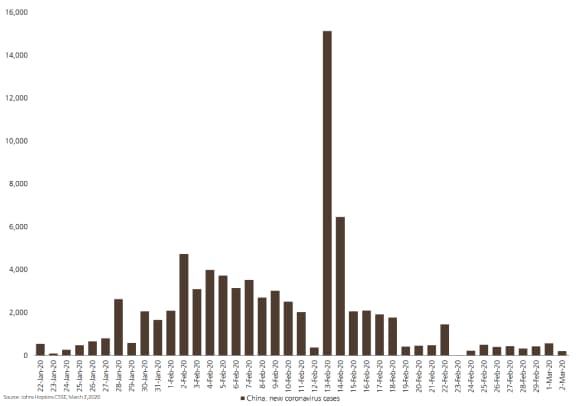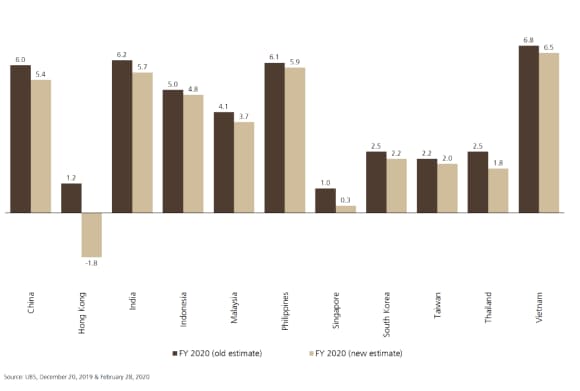Coronavirus and emerging markets: ears-to-the ground
.
By the Emerging Markets and Asia Equity team
By the Emerging Markets and Asia Equity team

Our team has been speaking with contacts on the ground in China and across Asia to understand the ramifications of the coronavirus outbreak. Based on our most recent conversations, we analyse the short- and long-term impacts of the outbreak across key sectors, particularly in China, and show how coronavirus is changing behavior and industries.
Key takeaways
Key takeaways
- The coronavirus outbreak will have a clear short-term economic impact on both China and economies throughout the Asia region;
- The extent and duration of the impact will depend on containing the spread in Asia and around the world, as well as the extent of policy support. China, Singapore and Hong Kong are already rolling out support measures;
- Global markets have only recently reacted negatively and could remain volatile in the near term; however, the long-term impact should be small;
- In China, the outbreak is accelerating a series of trends, including:
Ongoing industry consolidation: many smaller firms are finding it difficult to cope and will likely go out of business. Stronger and larger players are likely to benefit by growing market share.
An offline-to-online shift across business segments: more pronounced in industries such as after-school tutoring, banking, and healthcare diagnosis; offline-only businesses are likely to lose market share;
Investment in R&D and innovation: driven by growing demand for automated solutions, AI-driven technology, high-quality healthcare, as well as online entertainment and communication services;
Supply chain shifts: coronavirus provides additional impetus to diversify, and favored destinations are South-East Asia and India and reshoring, especially to North America, South Korea or Japan.
- We remain confident in fundamental, long-term changes playing out in emerging markets and our strategies are focused on quality companies associated with them.
- Despite market resilience in the wake of the coronavirus outbreak, we had remained cautious, thinking that investors may be too sanguine about the economic and earnings impact of the coronavirus. We continue to remain cautious but, as markets digest the situation, we are prepared to make portfolio changes at appropriate price points, especially by adding to positions in high-quality industry leaders.
Short-term impact significant, but stimulus measures are in the pipeline
Short-term impact significant, but stimulus measures are in the pipeline
The short-term impact of coronavirus on China's economy could be significant, largely because of the considerable precautions taken, like travel restrictions and factory closures.
However, the growth rate of new cases has slowed markedly in China while picking up pace elsewhere in the world.
China: new coronavirus cases, Jan 22nd, 2020 – Mar 2nd, 2020
China: new coronavirus cases, Jan 22nd, 2020 – Mar 2nd, 2020

In China, many large companies and state-owned enterprises have resumed work, but smaller companies face more of a struggle. Depending on the sector and progression of the situation, it is estimated that the impact of work disruptions could last for one to two quarters.
Government efforts to support China's economy have been considerable, including cuts to interest rates, cuts to selected banks' required reserve holdings (RRR), support for small-and-medium enterprises, and relaxation of home purchase restrictions in some parts of China.
In Asia, there will likely be spillover effects, with the heaviest impact on countries dependent on tourism, commodity exports and trade flows.
Taking Asian tourism as an example, Chinese tourists account for a large portion of tourist spending. In Thailand, tourist spending accounts for about 12% of GDP, and approximately 28% comes from Chinese tourists. Other Asian markets significantly exposed to Chinese tourism include Hong Kong SAR, Singapore, and Malaysia.
However, we are beginning to see support measures across the region, including stimulus measures in Singapore and Hong Kong SAR, infrastructure spending in Mainland China. Furthermore, there is a rising likelihood of further interest rate cuts.
FY2020: GDP Forecasts Across Asia: Old vs New
FY2020: GDP Forecasts Across Asia: Old vs New

Supply chain restoration underway; companies are relocating out of China, but they are not rushing
Supply chain restoration underway; companies are relocating out of China, but they are not rushing
In the shorter term, many industries across the world with parts of their supply chain linked to China will likely face supply constraints in Q1 and possibly Q2. The rest of Asia also has significant supply chain exposure to China.
On average, China accounts for 20% of imports in the rest of Asia. But the restoration of supply is now underway. For example, logistics companies who were operating at 15% capacity at the trough are now at about 80% capacity.
Large companies and SOEs have much higher work resumption rates, while small companies face more of a struggle. Coal mining, steel, food manufacturing have seen a faster pace of work resumption.
Restoration is slower in the auto sector, which is currently estimated to be at 30% capacity due partly to low expected demand.
Overall, the shorter term impact seems to be on the mend in China and by extension the rest of Asia, though there are downside risks with the virus now going global.
Even prior to Covid-19, the move to reduce dependence on the China supply chain had started, driven by rising costs in China and rising automation reducing labor cost differentials, the trade conflict and tariffs, and a general desire to diversify China risk. Covid-19 provides an additional impetus to diversify from the China supply chain.
This diversification is widespread across industries, but is a slow process.. Many companies are looking at a China plus one strategy, hence China will continue to be an important production base for companies.
Favored destinations are South-East Asia (with Vietnam the top destination), India and reshoring to North America, Korea or Japan.
Restructuring the supply chain is often accompanied by automation, benefitting factory automation companies. Selected companies in South-East Asia and India should also benefit, but the impact is more diffuse.
Our views across sectors
Consumer: expect a slowdown, but the extent of the impact will vary
Our views across sectors
Consumer: expect a slowdown, but the extent of the impact will vary
China's consumer sector will see a near-term growth slowdown, but the extent of the impact and the time of recovery will vary by each consumer sub-segment.
Enforced closures mean sub-sectors like restaurants, sportswear and spirits & beer are most exposed to the slowdown.
For example, Yum China announced that it had closed 30% of its restaurants in China1 and other chains like Xiabu Xiabu and Haidilao have also announced temporary closures.
Additionally, China's auto sector will likely see a significant drop in sales and production in the near-term: we're currently seeing 30%-50% utilization across the supply chain, and only 20%-30% of dealerships open in mainland.
It is highly likely that China's government will apply support policies, potentially in the form of cuts to purchase taxes, continued subsidies for electric vehicles, and increased license quotas.
Aside from hoarding of essential items, supermarkets and consumer staple sectors aren't likely to see meaningful long-term impact. Retailers with O2O (offline/online to online/offline) support will be less impacted than pure offline players.
Consumer: potential winners are online education, large restaurant chains and sports apparel sectors
Consumer: potential winners are online education, large restaurant chains and sports apparel sectors
Online after-school tutoring companies are seeing a surge in demand amid closures of offline classes, and we see this as an opportunity for leading online companies in the sector to take market share.
Leaders in the restaurant sector may benefit if, as we expect, smaller players are forced out of the market. Larger players can exploit the situation by securing good locations with favorable rental terms.
Organized and established players may also benefit in the long term if consumers put more emphasis on hygiene and health considerations when selecting restaurants. For the same reason, the food manufacturing sector may also see consolidation.
We expect more emphasis within China on sport and exercise since coronavirus has hit those already in poor health especially hard. Given high entry barriers, China's leading sports apparel companies, including Nike, Adidas, Li Ning and Anta, may see stronger sales coming from a heightened focus on staying healthy.
Internet: increased demand for virtual economy services
Internet: increased demand for virtual economy services
Online travel and on-demand food delivery have been adversely affected by travel & work restrictions in China as well as a shift toward home-dining and self-cooking amid restaurant closures and hygiene concerns.
The impact on e-commerce and online advertising in China has been relatively neutral.
For e-commerce, reduced sales of apparel and home appliances have been balanced by increased sales of health products and groceries. For online advertisers, ad spending from online games and education companies has been strong, but other advertisers have canceled their marketing budgets.
Virtual economy subsectors have benefited the most.
Take online gaming for example, user traffic grew between 30% and 50% during the Chinese New Year period. Social video providers like iQiyi, Bilibili, TikTok, and Kuaishou have seen increases in daily time spent, and online diagnosis services like Alihealth, Alibaba's online healthcare platform, and DXY (Ding xiang yuan), an online healthcare community site, have seen significant increases in demand.
Finally, software-as-a-service (SAAS) companies have seen a notable shift in demand. The most downloaded apps in Apple's China iOS store include work communication apps like DingTalk (owned by Alibaba), Zoom, and Enterprise Weixin (owned by Tencent).
Dingtalk has seen daily average users exceed 100 million, with total registered users growing to 300 million. Crucially, Dingtalk has penetrated government, educational and medical institutions, which could mean strong potential for further monetization.
Healthcare: expect big changes in China's health system; four key categories will likely benefit
Healthcare: expect big changes in China's health system; four key categories will likely benefit
In the short-term, patients are avoiding hospital visits which may adversely impact sales of treatments or drugs that have to be administered in hospitals.
At the industry level, the surge in cases highlighted vulnerabilities within China's primary healthcare institutions. As a remedy, we expect a concerted effort by the government to improve health services, which will likely boost demand for companies operating in the following areas:
- Testing equipment: such as polymerase chain reaction (PCR) testing and computerized tomography (CT) tools for lung imaging. China's National Medical Products Administration (NPMA) approved seven rapid-testing kits in late-January.
- Diagnosis: hospitals using a multi-department team (MDT) model that relied on cooperation between different departments were able to reduce the severity rate of the coronavirus cases in mainland China. We believe this would likely become a trend or working practice, which could boost investment in technologies that promote cooperation across regions.
- Treatment: including development of anti-viral drugs, improvement of blood plasma self-sufficiency, and establishment of critical care medicine and intensive care units (ICU). Demand is high for devices and materials to enhance basic ICU infrastructure, like defibrillators, ECGs, blood purifiers, and biochemistry analyzers. Most of these devices are imported and we believe that domestic players will strengthen product innovation and design capabilities to meet higher demand.
- Preventative solutions: such as high-quality vaccines.
Financials: slower environment in 1H20, digital offerings will be key differentiator
Financials: slower environment in 1H20, digital offerings will be key differentiator
The biggest short-term impact from coronavirus will be on business segments driven by face-to-face interaction, like insurance and wealth management. This is especially so in China and the most affected parts of certain Asian cities.
In China, movement restrictions and the shut down of commercial activities have hurt loan demand. Asset quality pressure is growing amid weaker cashflow, but this is being offset to some degree by government efforts to boost liquidity and bank steps to relax payment terms.
In the rest of Asia, so far the impact of coronavirus has been minimal because official responses have been less draconian and the disease has spread more slowly compared to China. However, the virus is gradually affecting economic activity through reduced tourism, social gatherings and delayed supply chains.
We expect government support measures, including liquidity support for small-and-medium enterprises, cash handouts, and relaxed recognition of non-performing loans to ensure lending lines continue. A slower business environment is expected in 1H20, but most companies predict a fast rebound in 2H20 if the spread of the virus abates.
The virus outbreak will accelerate the push into digital banking, as well as increase scrutiny on banks' digital capabilities. Those having done the best job are in line to benefit.
Online lending
Online lending
In China's online lending industry, loan volumes are down significantly y-o-y, partly due to lower demand but also due to lenders' tighter policies, which have lowered approval rates and favored only existing borrowers.
Management are seeing asset quality pressure and higher delinquencies are likely. Currently, loan collection teams have returned to 80% of the normal capacity.
Banks and financial institutions are hungry for high-quality assets as they are required to provide more lending but there is a lack of high-quality borrowers in the market. The large online lending platforms, acting as the loan facilitator, may be a potential source of assets for them.
Semiconductors: short-term supply challenges, increased long-term demand for connectivity
Semiconductors: short-term supply challenges, increased long-term demand for connectivity
End demand will slow in the short-term. On the supply-side, companies will likely have to deal with falling end demand, securing sufficient upstream components; managing the return and safety of workers coming back into the production line for those with manufacturing facilities in China
Looking longer-term, this current crisis may lead to greater demand for devices that facilitate offsite work and interaction. Such devices require better connectivity, mobility, bandwidth and so on, so greater investment in networks and datacenters is likely.
On the supply side, this crisis may highlight the risk of concentrating production in one country or region and may accelerate the relocation of some manufacturing facilities away from China. Investment in automation may also pick up pace.
Industrials: automation and surveillance long-term winners; oil industry consolidation afoot
Industrials: automation and surveillance long-term winners; oil industry consolidation afoot
China's government will pressure utility companies to cut prices and power plants (coal-fired and nuclear) and sewage treatment companies will be most impacted. Gas distributors enjoy a degree of pricing power due to their quasi-monopoly status and should be less affected.
Within industrials, subsectors exposed to long and complicated supply chains are most exposed such as auto glass providers and construction companies.
However, automation and surveillance companies may be long-term winners. Demand for robotics systems and surveillance, such as in warehouses, has the potential to rise. Additionally, surveillance technology with infra-red thermometers or AI, was widely used to help detect, monitor and track patients and quarantined individuals.
Oil refineries are seeing much slower demand, with some estimates putting the shortfall at 20%-30% of global oil consumption. On the supply side, large state-owned refineries have cut run rates by 10% to 13% while private entities have cut less.
Small, 'tea-pot' refineries have cut run rates by 40%-50%, the lowest level in the past five years. If the current situation continues, industry consolidation may accelerate, which may be positive for private integrated refineries with lower cash cost levels.
Looking regionally, there's further potential downside for refineries. Mainland China will likely see an inventory build-up, which may mean increased exports in 2Q20 and margin pressure for regional refineries. Furthermore, the recent global spike in cases will probably drive a further decrease in demand, thus forcing run rate cuts for regional refineries.
Real estate: sales will slow, industry consolidation to accelerate
Real estate: sales will slow, industry consolidation to accelerate
Sales and construction in China will take at least a month or two to ramp up. Developers are unlikely to launch projects until late-March and the slow return of migrant workers will weigh on project builds. .
An imminent liquidity crisis is unlikely, but smaller developers will continue to face difficulties – media are reporting 80 bankruptcies for small developers YTD, compared to 400+ in FY 2019.
Weak sentiment and tight financing will likely drive consolidation, with state-owned enterprises and larger developers likely to gain market share.
Retail landlords in general will be more negatively impacted. They need to assist tenants because of lost sales. Moreover, the shift of purchasing behavior from offline to online will quicken, potentially resulting in long term loss of business for retail landlords.
